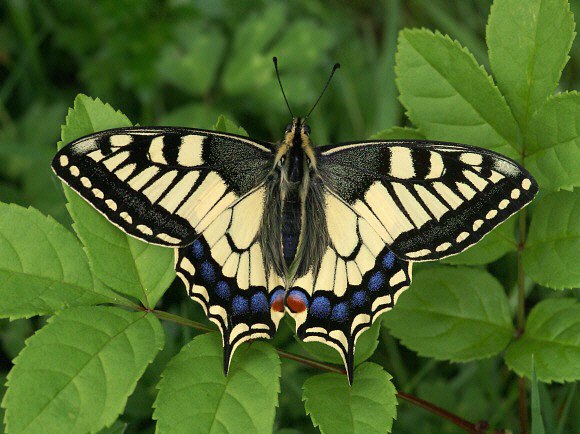 Papilio machaon gorganus, St Germain l’Herm, Auvergne, France – Adrian Hoskins
Papilio machaon gorganus, St Germain l’Herm, Auvergne, France – Adrian Hoskins
Introduction
Back in the 18th century when Linnaeus created the System Naturae, the word Papilio was used as the genus name for every known species of butterfly in the world. Since then much has been learnt about the relationships between different species. Consequently most have been reassigned to new genera, and only about 215 of the 17600 currently known species are retained in Papilio.
Papilio machaon is widespread and common throughout much of the northern hemisphere. It occurs over the whole of continental Europe, eastward across temperate Asia to Japan; in Africa north of the Sahara; and throughout much of North America. In Britain it is locally common on the Norfolk Broads, an area of fenland and lakes in eastern England.
Individuals originating from France occasionally migrate across the English Channel and have been periodically recorded in Hampshire, Dorset, Sussex and the Isle of Wight, but such sightings are very rare – perhaps one or two sightings per year. Genuine migrants can usually be recognised by their faded and worn appearance. Fresh looking insects seen anywhere apart from Norfolk can be attributed to escaped or deliberately released livestock – both the British subspecies brittanicus and the continental gorganus are commonly reared by hobbyists. ( it is illegal to capture or breed stock of British origin, but nevertheless a widespread practice ).
There are no similar species occurring in Britain. On the Mediterranean islands of Corsica and Sardinia machaon shares it’s habitat with Papilio hospiton, which is similarly marked but has much shorter tails on the hindwings. In Algeria the distribution of machaon overlaps that of the Saharan Swallowtail Papilio saharae, which is identical in appearance except for the antennae, which have 30 segments in saharae, and 33-36 segments in machaon.
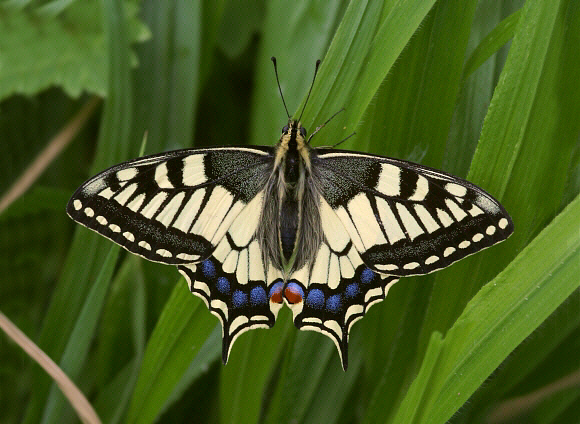 Papilio machaon gorganus, female, Mont Dore, France – Adrian Hoskins
Papilio machaon gorganus, female, Mont Dore, France – Adrian Hoskins
Habitats
Throughout most of it’s range the Swallowtail shows itself to be highly adaptable, utilising a wide variety of habitats including sub-arctic tundra in Canada, prairies, woodlands and arid canyons in the south of the USA; hay meadows, roadside verges, river banks and sub-alpine pastures in Europe; high montane habitats in the Atlas mountains of north Africa, and semi-cultivated habitats in the Mediterranean area.
It’s adaptability extends also to it’s choice of foodplants – in North America the caterpillars usually feed on Compositae ( Artimesia, Petasites ), while in Europe Rutaceae ( Ruta, Haplophyllum ) and Umbelliferae ( Foeniculum, Peucidanum etc ) are used instead. In Britain however the butterfly is restricted to a single foodplant – milk parsley, and breeds only at a very small number of wet fenland habitats in north-east Norfolk. Individual specimens have been tagged and found to fly over quite a large area, often reaching adjacent fens, but the butterflies do not stray beyond the general area of the broads.
Several centuries ago the species almost certainly occurred as a resident species over a much wider area of southern and eastern England, but later contracted it’s range to the Great Fen – a vast area of wetlands covering Cambridgeshire, Lincolnshire and Norfolk. Following the drainage of this area, and it’s conversion to agriculture, the butterfly was forced to contract it’s range even further – to the Norfolk Broads. In such isolation the genetic diversity would have diminished, causing the so-called “sub-species” machaon brittanicus to become far less adaptable, and to acquire minor differences in appearance from the ancestral stock.
In the last 100 years the average wingspan of Swallowtails, and the average width of the thorax, have reduced in size, an indicator of further genetic impoverishment, which is likely to result in further contraction and eventual extinction. Expansion of the gene pool can only be accomplished by the introduction of genetically richer livestock from Europe, a policy which hopefully will eventually be adopted by conservation groups.
Although the butterfly only breeds in the wet fenlands and broads of Norfolk, migrants from France are periodically observed at coastal sites in Dorset, Hampshire, the Isle of Wight, Sussex and Kent. On 1st Sept 2003 for example I watched an immigrant Swallowtail flying across a main road at Milford-on-Sea in Hampshire. In most years less than half a dozen are recorded, usually in August or September. Individuals very occasionally penetrate further inland, and are reputed to sometimes breed on chalk grasslands, reportedly feeding as larvae on wild carrot Daucus carota, although I know of no recent records.
It is planned that by the end of the 21st century the Great Fens which formerly occupied much of eastern England will be partially restored, leading to a sizeable increase in suitable habitat. Whether such a project is feasible in the face of population expansion however remains to be seen.
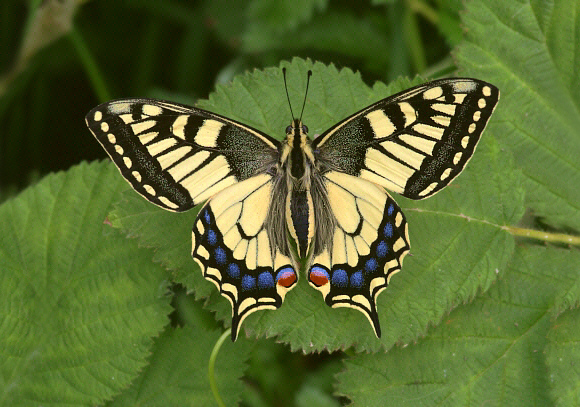 Papilio machaon gorganus, Loire valley, France – Adrian Hoskins
Papilio machaon gorganus, Loire valley, France – Adrian Hoskins
Lifecycle
The butterfly is bivoltine on the continent, emerging in May and August, but in Britain the second brood is either partial or non-existent.
In the Norfolk fens where the butterflies emerge in late May, they lay their large brown globular eggs singly on the fine leaves of milk parsley Peucidanum palustre. The eggs are nearly always laid on the upper foliage of tall plants which project above the surrounding reedbeds. They hatch after about a week.
The young caterpillar is black, marked with a band of white. It looks remarkably like a small bird-dropping as it rests openly on the leaves. According to Thomas the camouflage is not effective against spiders, which may predate up to 65% of 1st instar larvae. When fully grown in July, the caterpillar is a most magnificent creature – bright green, marked with narrow black bands and orange spots. Behind it’s head is an eversible fleshy pink forked structure called an osmaterium, which is raised if the larva is irritated. This structure emits pungent chemicals, capable of deterring ants, wasps, and flies, but does not deter birds – reed buntings, sedge warblers and bearded tits between them devouring at least 50% of mature larvae.
The chrysalis occurs in 2 colour forms, being either plain green, or light brown with a dark lateral stripe. It is attached vertically by a thin silken girdle and by the cremaster, usually low down on the stem of a reed, where it hibernates until the following May.
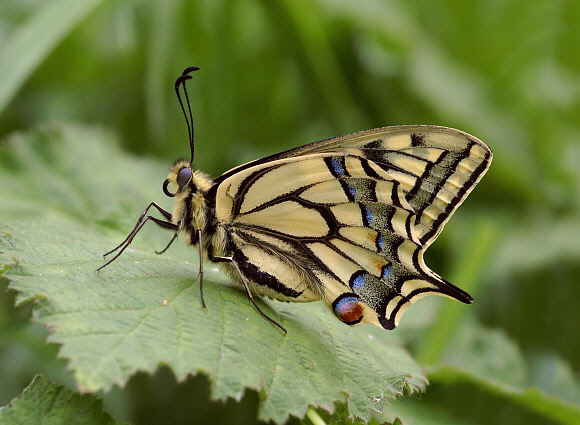 Papilio machaon gorganus, Loire valley, France – Adrian Hoskins
Papilio machaon gorganus, Loire valley, France – Adrian Hoskins
Adult behaviour
The butterfly has a characteristic powerful gliding flight, and is capable of covering large distances. In France and Spain for example I have often observed males indulging in “hill-topping”, i.e. flying to congregate at the top of hills, where they compete for the attention of passing females. In Britain the butterfly breeds only on the flat terrain of Norfolk, and probably only covers short distances, although it can be seen crossing open expanses of water on the Broads.
On warm sunny days, male Swallowtails patrol back and forth along a regular route in search of females. Often both sexes home in on a particular clump of bushes where courtship and copulation take place. The pair often remain joined for 2 or 3 hours before the female departs to oviposit.
In the morning, and again in late afternoon both sexes can be seen flying freely about their habitat, pausing regularly to nectar at the pink flowers of angelica, knapweeds, marsh thistles, red campion, ragged robin and valerian. When nectaring they keep their wings constantly fluttering to prevent the weight of their bodies from dragging down on the fragile flowers. This fluttering behaviour is typical of all Papilioninae, wherever they occur in the world. In Norfolk the butterflies also often nectar at the spectacular bright yellow flowers of yellow iris.
In cool but sunny weather, or during periods of hazy sunshine, Swallowtails can sometimes be seen basking amongst dry grasses. During overcast weather they roost hanging from reed stems, and probably also amongst the foliage of sallow and alder bushes, and other fenland vegetation.
In the French Alps and the Pyrenees the butterflies commonly indulge in mud-puddling – siphoning mineral-rich moisture from damp mud and cattle dung, but I have not observed this behaviour in Britain.
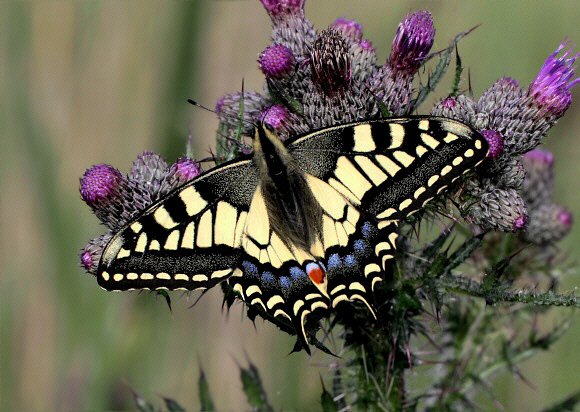
Swallowtail Papilio machaon, River Bure, Norfolk – Adrian Hoskins
